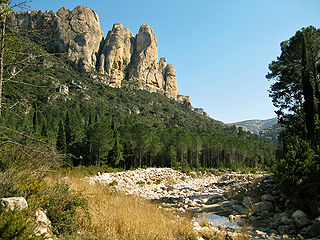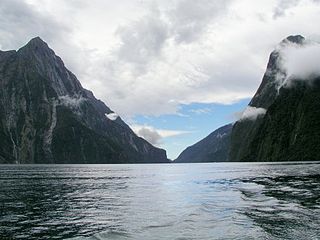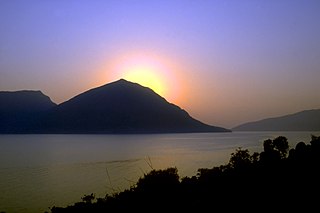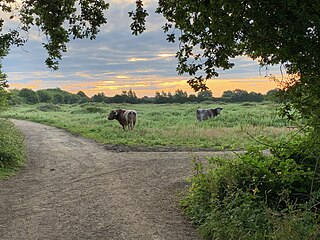
Protected areas or conservation areas are locations which receive protection because of their recognized natural, ecological or cultural values. There are several kinds of protected areas, which vary by level of protection depending on the enabling laws of each country or the regulations of the international organizations involved. Generally speaking though, protected areas are understood to be those in which human presence or at least the exploitation of natural resources is limited.

Natura 2000 is a network of nature protection areas in the territory of the European Union. It is made up of Special Areas of Conservation and Special Protection Areas designated under the Habitats Directive and the Birds Directive, respectively. The network includes both terrestrial and Marine Protected Areas.
This is an index of conservation topics. It is an alphabetical index of articles relating to conservation biology and conservation of the natural environment.
The following outline is provided as an overview of and topical guide to sustainable agriculture:

Habitat conservation is a management practice that seeks to conserve, protect and restore habitats and prevent species extinction, fragmentation or reduction in range. It is a priority of many groups that cannot be easily characterized in terms of any one ideology.

Marine protected areas (MPA) are protected areas of seas, oceans, estuaries or in the US, the Great Lakes. These marine areas can come in many forms ranging from wildlife refuges to research facilities. MPAs restrict human activity for a conservation purpose, typically to protect natural or cultural resources. Such marine resources are protected by local, state, territorial, native, regional, national, or international authorities and differ substantially among and between nations. This variation includes different limitations on development, fishing practices, fishing seasons and catch limits, moorings and bans on removing or disrupting marine life. In some situations, MPAs also provide revenue for countries, potentially equal to the income that they would have if they were to grant companies permissions to fish. The value of MPA to mobile species is unknown.

Kálamos, is a mountainous island and a former community in the Ionian Islands, Greece. Since the 2011 local government reform it is part of the municipality Lefkada, of which it is a municipal unit. It lies east of Lefkada, near the Greek mainland. It has an wintering population of around 500 people, which is swelled substantially in the summer by tourists. The name Kalamos means reed in Greek and the presence of this plant along its coastline in the past may have given its name. Another version is that the island had several beaches with good sand hence the name given. Its population was 496 at the 2011 census. The land area is 24.964 km2 (9.639 sq mi), and its highest point is 754 m (2,474 ft) above sea level.
Ecotechnology is an applied science that seeks to fulfill human needs while causing minimal ecological disruption, by harnessing and manipulating natural forces to leverage their beneficial effects. Ecotechnology integrates two fields of study: the 'ecology of technics' and the 'technics of ecology,' requiring an understanding of the structures and processes of ecosystems and societies. All sustainable engineering that can reduce damage to ecosystems, adopt ecology as a fundamental basis, and ensure conservation of biodiversity and sustainable development may be considered as forms of ecotechnology.

The Tethys Research Institute is a non-profit research organisation founded in 1986 to support marine conservation through science and public awareness. The institute has its headquarters at the Civic Aquarium of Milan, Italy. Tethys' activities are mainly carried out in the Mediterranean Sea, although research programmes have been conducted also in the Black Sea, the North Atlantic Ocean, the Caribbean as well as in the Red Sea and Antarctica. The results of these activities have been presented in scientific publications as well as in meetings, workshops and conferences.
The School for Field Studies (SFS) is the United States' largest environmental study abroad program provider for undergraduate college students, offering fully accredited semester- and summer-long academic programs in over 10 countries around the world. SFS students and staff conduct field research, driven by strategic research plans, to address environmental issues which affect both the communities in which the organization operates and the world in general. More than 18,000 students have studied abroad with SFS since it was founded in 1980. SFS is a 501(c)(3) non-profit organization, currently based out of Beverly, Massachusetts.

Earthwatch Institute is an international environmental charity founded as Educational Expeditions International in 1971 near Boston (USA) by Bob Citron and Clarence Truesdale, then superintendent of Vermont public schools. It is one of the global underwriters of scientific field research in archaeology, paleontology, marine life, biodiversity, ecosystems and wildlife. For over forty years, Earthwatch has delivered a unique citizen science model to raise funds and recruit individuals, students, teachers and corporate fellows to participate in critical field research to understand nature's response to accelerating global change. Earthwatch's work supports hundreds of Ph.D. researchers across dozens of countries, conducting over 100,000 hours of research annually.

Rewilding, or re-wilding, activities are conservation efforts aimed at restoring and protecting natural processes and wilderness areas. This may include providing connectivity between such areas, and protecting or reintroducing apex predators and keystone species.

The natural environment, commonly referred to simply as the environment, includes all living and non-living things occurring naturally on Earth.

Hotspot Ecosystem Research and Man's Impact On European Seas (HERMIONE) is an international multidisciplinary project, started in April 2009, that studies deep-sea ecosystems. HERMIONE scientists study the distribution of hotspot ecosystems, how they function and how they interconnect, partially in the context of how these ecosystems are being affected by climate change and impacted by humans through overfishing, resource extraction, seabed installations and pollution. Major aims of the project are to understand how humans are affecting the deep-sea environment and to provide policy makers with accurate scientific information, enabling effective management strategies to protect deep sea ecosystems. The HERMIONE project is funded by the European Commission's Seventh Framework Programme, and is the successor to the HERMES project, which concluded in March 2009.
Tundi Agardy is a marine conservationist and the founder of Sound Seas – a Washington DC-based group specializing in working at the nexus of marine science and policy in order to safeguard ocean life.

Giuseppe Notarbartolo di Sciara is an Italian marine conservation ecologist who has bridged the worlds of marine science, conservation and policy.

For a small country, Albania is characterised by a considerable wealth of terrestrial and marine ecosystems and habitats with contrasting floral and faunal species, defined in an area of 28,748 square kilometres. Most of the country is predominantly of Mediterranean character, comprehending the country's center and south, while the alpine affinity is more visible in the northeast.

Roberto Cazzolla Gatti is an Italian environmental and evolutionary biologist with a Ph.D. in ecology. His research deals with Biological Diversity and Conservation, and Global Environmental Protection occurring, therefore, at the interface between macroecology, evolutionary biology, and behavioural ecology.















